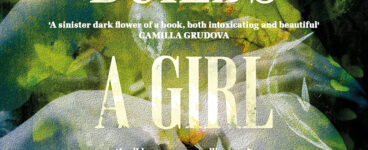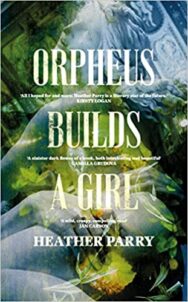‘As the story progresses, the characters’ mental states become more and more exposed and the lines between truth and fantasy become blurred, exposed, and blurred again.’
Nasim Asl is both impressed and disturbed by Heather Parry’s debut, Orpheus Builds a Girl.
Orpheus Builds a Girl
By Heather Parry
Published by Gallic Books
For millennia, women’s bodies have been objectified, commodified and politicised. We can see the battle for women to have the right to make decisions about their own bodies still playing out around the world. In Iran, women are protesting for the right to show their hair in public. In the US this year, the overturning of Roe vs Wade means some women are limited when it comes to making choices about their own bodies.
In her debut novel, Orpheus Builds a Girl, Heather Parry explores how even in death women can lose agency of their bodies to the absolute extreme. She’s crafted a novel that is mesmerising, grotesque, sympathetic and gripping in equal measure. Parry’s work is simultaneously both of our time but could have been written during the original gothic period of literature, so strong is her storytelling voice.
Loosely based on a story featured in the Our American Life podcast, in which a German man working in a hospital became obsessed with a young Cuban-American patient before digging up her body and keeping it in his home, Orpheus Builds a Girl follows a similar plot. The Nazi scientist Dr Wilhelm von Tore – the Orpheus in this tale – flees Germany and moves to the US. Living under a false identity, he works in a hospital. At the same time, we follow the life of Luciana, the titular ‘Girl’, as told through the eyes of her sister Gabriela as the two grow up in Cuba, leave during Castro’s regime, and enter womanhood as immigrants in Florida.
The story is told via alternating chapters, covering different historical periods and the two storylines merge around a third of the way through the novel, when Luciana, suffering from uncurable tuberculosis, meets Wilhelm. Cue his obsession with her, his eventual control of both her dying and dead body and her sister Gabriela’s years long fight for justice and peace. Sounds simple enough, but Wilhelm has been long consumed with dreams of undoing death, and the novel takes a dark and grisly turn; squeamish readers may find themselves skimming certain paragraphs.
While the time jumping between chapters can take a little while to register and adjust to, the two voices are powerful and the characterisation is distinct. It’s obvious which narrator is speaking when, and the use of contrasting language and voice is fascinating. Wilhelm’s chapters are filled with pseudo-scientific vocabulary, and there’s a gruesome viscerality in his descriptions of the body that contrast sharply with his more emotive ramblings. Both characters are consciously narrating and speak directly to the reader – Wilhelm believes he has written a ground-breaking memoir and scientific paper that challenges everything medicine knows about death, while Gabriela is writing emotively to expose Wilhelm’s obvious moral deficiencies and regain some control of her family’s narrative. The domesticity and familial focus of her sections contrast unnervingly with the at-times uncomfortable experience of reading Wilhelm’s interior monologue, which serves to further the moral chasm between the two.
The two characters are worlds and generations apart, but both their geopolitical contexts are fascinating. Parry is successful in constructing believable and fascinating characters, and some of the horror of the novel comes from how firmly established in historical reality the characters are – they feel unnervingly real.
As the story progresses, the characters’ mental states become more and more exposed and the lines between truth and fantasy become blurred, exposed, and blurred again. So persuasive is the voice of Wilhelm that at times I questioned the veracity of the possibility of his experiments, before rapidly reprimanding myself. Credit to Parry’s pen. Though the pacing of the narrative felt slightly imbalanced and the expositionary childhood passages at the start of the novel could feel a little long – especially before the two character’s lives intersect and the narrative thrust really takes shape – the research that went into the historical and political context can’t be underestimated and undeniably contributed to the authenticity of the novel.
Women and power lie at the heart of Parry’s book. The domination and control Wilhelm displays throughout the narrative is best encapsulated as the deranged doctor screams Luciana is his ‘object’ and ‘personal property’. Throughout, Parry explores the ownership of the body in death as well as in life. Some of the most moving scenes in the novel are expressions of sisterhood and love between Gabriela and Luciana, and the gentleness that exists between them even through some harrowing moments is a perfect foil to the grossness of Wilhelm’s narrative. Through the Madrigal family, large themes and topics are exposed – Parry weaves stories of immigration, racism, the American dream, the medical and social treatment of women as well as their sexual liberation, the spectre of fascism, authoritarian regimes and the failure of authorities through the plot.
It’s a novel that feels incredibly timely. Society’s fascination with the macabre is as noticeable as its ever been, if the endless ream of murder documentaries and podcasts available to stream are any indication. At the time of writing, the series Dahmer is topping the Netflix chart. We still have a morbid fascination with humans who represent the worst of us. Taboo subjects are compelling and the theatre of the grotesque is clearly addictive – despite the wishes of victims and their families. Parry makes us question our role as voyeurs in this tradition, and exposes our complicity as violence, death and desecrated bodies are used as entertainment – and more often than not, it’s women and minorities who suffer the most dehumanisation. Luciana is the perfect example of this.
Indeed, it was only as Orpheus Builds a Girl drew to its close, that I realised that in a novel focused so intensely and explicitly on the life, death, body and corpse of a woman, we did not hear Luciana’s voice directly. There’s no justice, no remorse. That in itself, is its own tragedy, and it’s one that Parry exposes with haunting subtlety.
Orpheus Builds a Girl by Heather Parry is published by Gallic Books, priced £12.99.
ALSO IN THIS ISSUE

 Puffins
Puffins
My first tentative steps into wildlife photography came from visiting a local pond and taking photog …

 Nasim Asl Reviews: Orpheus Builds a Girl
Nasim Asl Reviews: Orpheus Builds a Girl
‘As the story progresses, the characters’ mental states become more and more exposed and the lines b …













